I have owned several sailboats and loved the romance of sailing, but as I’ve aged it was requiring more work and scampering about than I enjoyed. When my friend George took my wife Donna and me on a short motor cruise of the western end of New York State’s Erie Canal, I found it to be a relaxing and beautiful experience, quite different from sailing on the turbulent waters of Lake Erie. I decided to build a boat for cruising the canal.
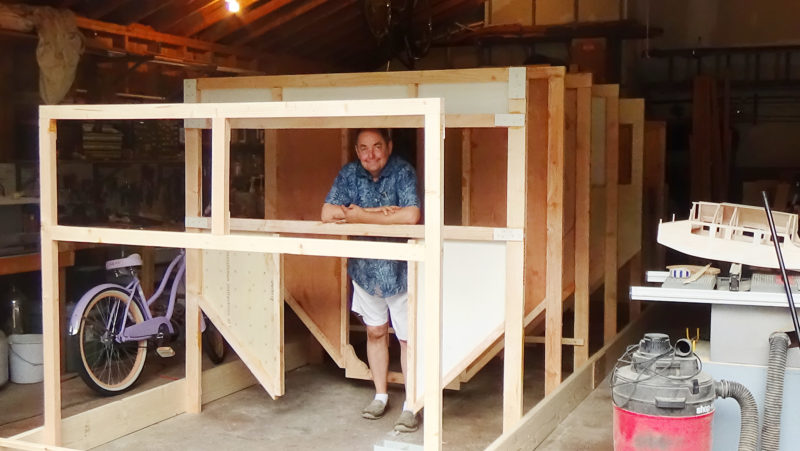 Donna Harris
Donna HarrisThe L’Ark is built upside down with the posts on the transom and bulkhead sides extended to a common baseline. The extra length gets cut off after the hull is rolled over.
We wanted a relatively small trailerable boat that was suitable for overnight travel. It had to have a galley, a head, and berths for at least two. I also wanted a boat that had a traditional appearance and used readily available materials, not exotic and costly tropical hardwood. And, it had to be possible to build it in my double garage with the tools that I had on hand and with my limited boatbuilding skills. When I came across Philip Thiel’s Escargot, it seemed to fit the bill except for its lack of standing headroom. I noticed that the Escargot plans include four pages of supplemental drawings for a modified version, L’Ark, with the same 18′ 6″ length. This four-berth plywood canal cruiser has 6’ standing headroom, a 6″ greater beam than the Escargot’s 6′, and steeply sloped cabintop sides. It looked perfect. I ordered the plans and built a scale model to give me a clear understanding of how the hull was constructed (it is a lot less expensive to make a mistake in balsa than in marine plywood).
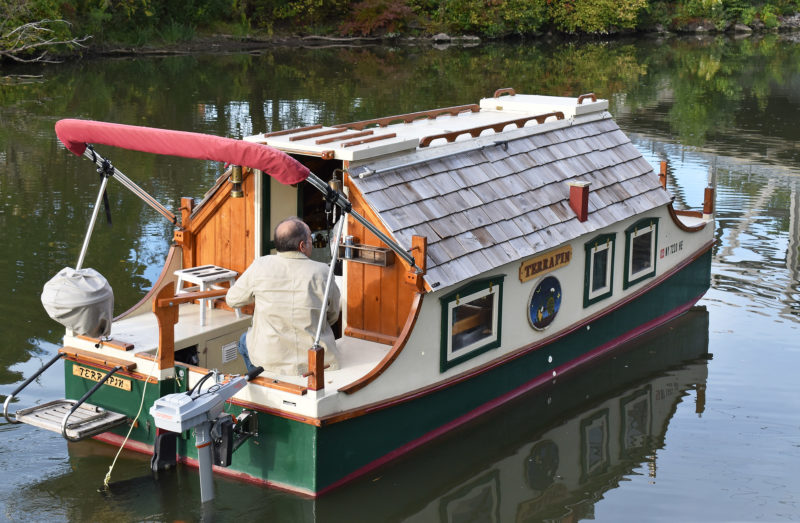 Roger Allen
Roger AllenThe L’Ark is drawn with a centered motor mount for an outboard to provide power and steering. The offset mount and centered rudder were borrowed from the Escargot plans but the arrangement proved more difficult to operate than the outboard-only setup.
I started construction of our L’Ark on the Fourth of July, 2016. I laid out and put together the seven frames on an 8′ x 8′ level plywood platform. To keep the frame pieces from shifting during construction, I added some cleats to make sure everything lined up and stayed put. I used good quality 1/2″ Douglas-fir marine-grade plywood. The plans call for 3/8″ plywood transoms and sides, but I found the 1/2″ to be less expensive and locally available. For the timbers, I was fortunate enough to have a lumberyard that would allow me to sort through the common 2x12s, which I ripped down into clear pieces. I used silicon-bronze fastenings as recommended in the plans; stainless and galvanized fastenings are listed among the options.
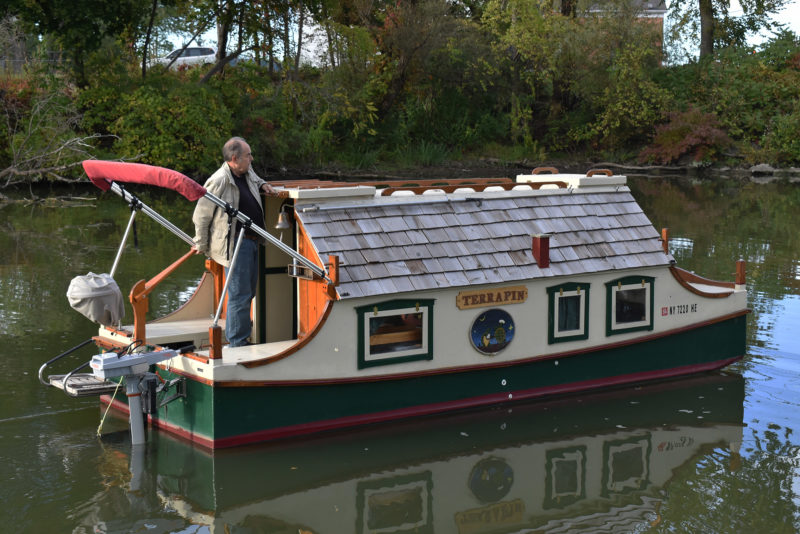 Roger Allen
Roger AllenOrdinarily the L’Ark would have an uninterrupted aft deck instead of a footwell. To compensate for the loss of height the author stands on a box to get a better view over the cabintop.
The seven completed frames were set up, upside down and squared to a leveled strongback. The plywood sides, previously made up of three sections and joined by plywood butt straps, were then glued and fastened to the frames, followed by the bottom panels, made up of five sections, also butt-strapped. I covered the bottom below the waterline with fiberglass cloth and sealed everything inside and out with two applications of epoxy. After two coats of antifouling paint, the boat was ready to turn right-side up.
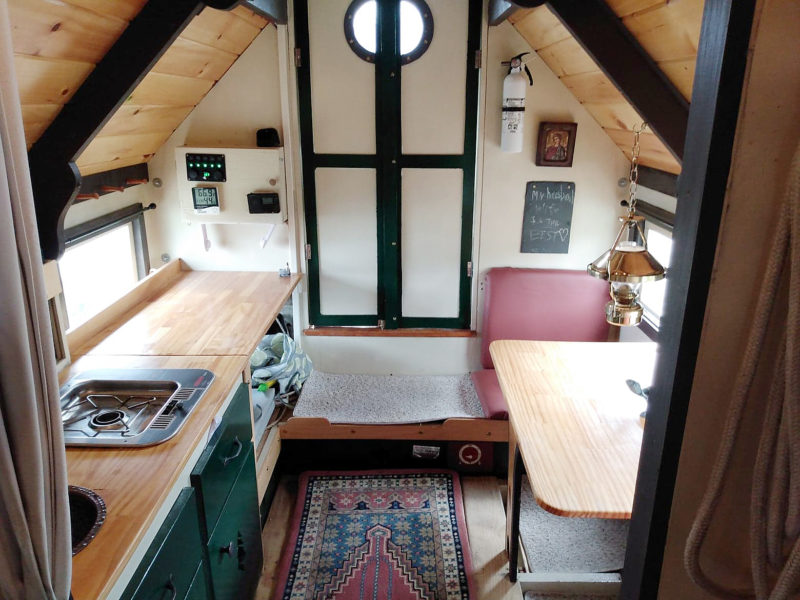 David Harris
David HarrisStanding headroom makes it much easier to prepare meals in the galley. As designed, the bottom of the door leading to the cockpit would be about level with the countertop and a three-step ladder would be fitted in the cabin.
The hull at this time weighed about 700 to 800 lbs and was ready to flip right-side up. The instructions recommend having 10 people, five on each side, to roll the 500-lb Escargot. I sent out an open invitation to a boat-flipping party and almost 30 people showed up. All went well and, with the hull right-side up and set on appliance dollies, I was able to move the boat around in my garage if I wanted to make room for a car or to make it easier to work on all sides.
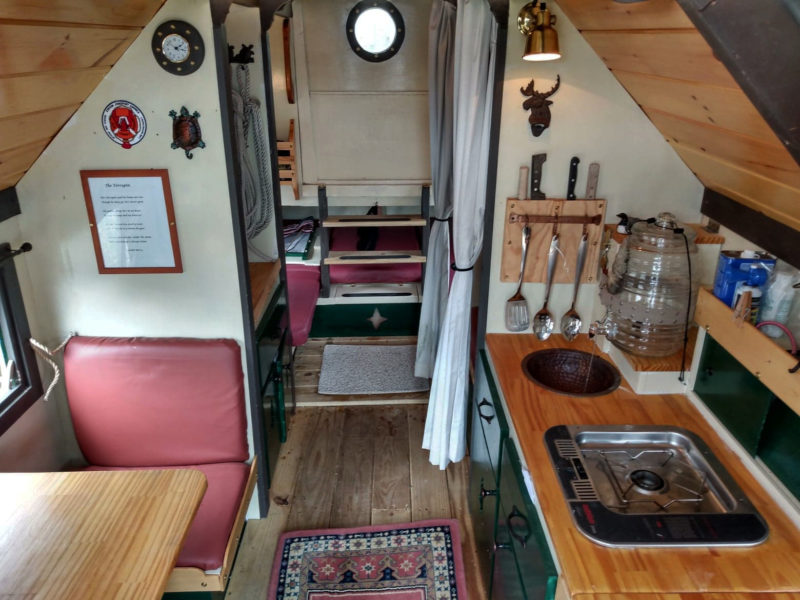 David Harris
David HarrisThe author added floorboards that are not included in the plans. Setting the boards across the tops of the frames reduced headroom by a few inches but eliminated potential trip hazards while moving around the cabin. The ladder between the two forward berths leads to the foredeck.
Before putting the cabintop on, I built and installed cabinets for the head and galley. I wanted the boat to have a traditional look inside and out, so I opted for 3/4″ tongue-and-groove knotty pine for the ceiling instead of the 1/4″ plywood called for. The pine added significant strength, stiffness, and aesthetic appeal.
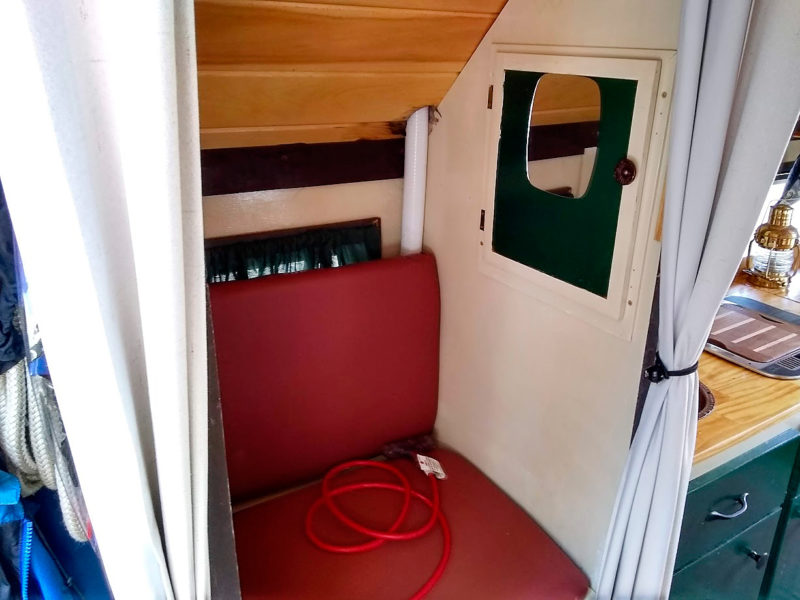 David Harris
David HarrisThere are two 24″-wide compartments between the saloon and the forward berths. The plans indicate one is for a head. The curtains here provide a measure of privacy.
During the long cold winter, a small space heater in the cabin made it possible for me to work on the boat’s interior in comfort but I kept tripping over the frames, so I installed 5/4 pressure-treated yellow pine floorboards over them. This reduced the headroom to 5′ 10″ (fortunately, still an inch taller than my height). The pine also added the more traditional appearance that I was looking for and would keep things dry, even if a little water found its way into the bilge.
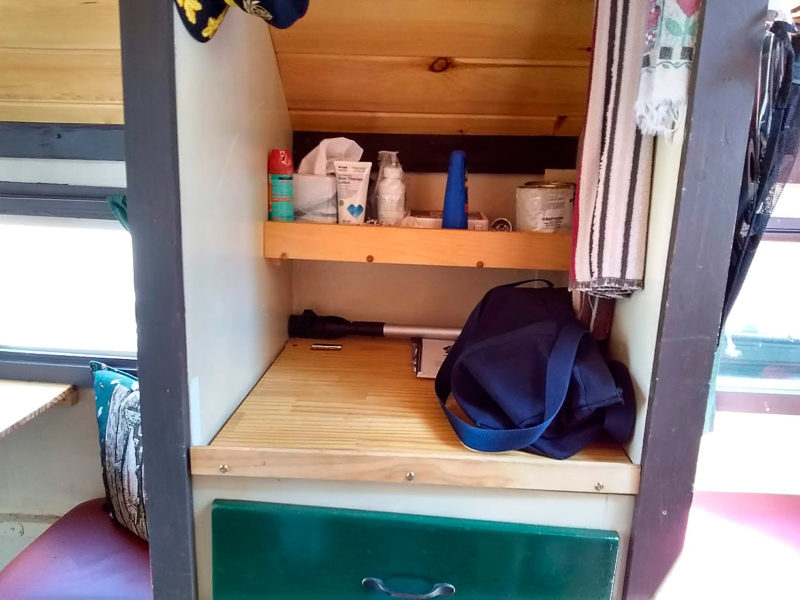 David Harris
David HarrisThe compartment opposite the head is for storage.
The plans called for sliding windows and hatches. This looked complicated to build and only half of each window opens, so I built simpler hinged awning windows. This has worked out well. I also made hinged hatches instead of sliding hatches to free up the flat area of the cabintop for seating and storage. The companionway hatches also act as air scoops and provide plentiful airflow while underway and at the dock.
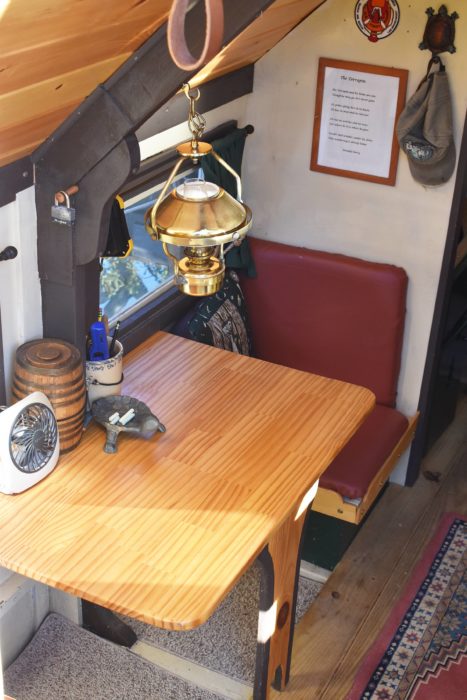 Roger Allen
Roger AllenWhile the plans call for a fixed table in L’Ark, Escargot’s table can be lowered to create a berth or bench. On L’Ark, the aft berths (not shown here) are accommodated on the aft seats and flats that extend beneath the aft deck.
L’Ark, as designed, has a flat deck at either end, each built over the foot ends of a pair of berths. A bench made of 1/2″ galvanized pipe is meant to be installed in the stern, but I didn’t like the way it looked and instead made the rear deck like the cockpit of a sailboat with a bench on either side and a self-draining footwell in the middle. Under one side bench is a ventilated compartment for batteries and an open area for gas tanks. Enclosed under the other bench is one of the remaining berths, which extends into the cabin. My cockpit footwell also allowed for a taller entry into the cabin. For the forward companionway, I opted to make it like a sailboat’s with a pair of removable plywood hatchboards. This proved to be a mistake, because they were awkward to remove and took up valuable space to store when not in place; I plan to install a split, hinged door.
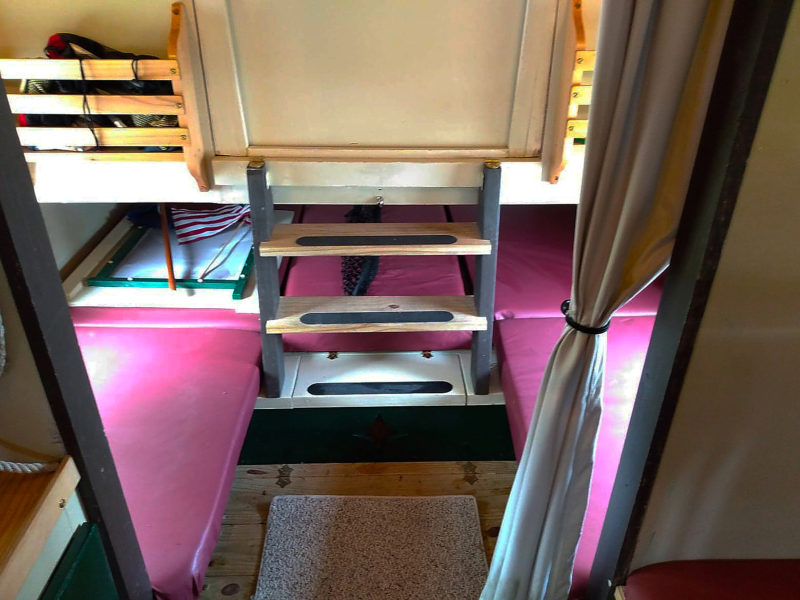 David Harris
David HarrisBeneath the forward berths there is lots of storage space accessed via removable plywood panels under the cushions. The ladder is easily removed and, with the addition of another plywood panel and cushion, a king-sized berth is created.
I covered the tongue-and-groove pine ceiling with 1/4″ plywood, taped the seams with fiberglass, and coated the whole thing with epoxy followed by paint. This was certainly leakproof, but it looked merely okay; I considered corrugated metal for a finished roof but decided on red-cedar shakes, which added a lot of character to the boat.
The plans for the L’Ark indicate a centered outboard bracket; the outboard motor would be used for steering. I built and installed the rudder and tiller and installed a motor to one side, as shown for the Escargot. While the tiller/rudder added a traditional look, the tiller took up too much space in the cockpit, and handling the tiller and motor at the same time proved awkward when docking. I decided to eliminate the rudder and mounted the motor in the center as per L’Ark’s plans. I found a 6-hp sailboat outboard with an extra-long shaft that fit perfectly on the transom without the need for a bracket. It also had a modified prop that was designed not for speed but to move a heavy boat.
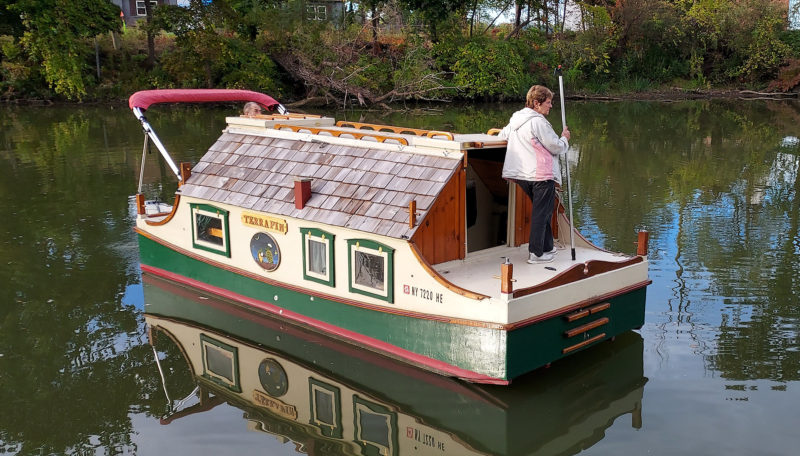 Roger Allen
Roger AllenThe foredeck has space for two folding chairs; passengers can escape the noise of the outboard and enjoy the view in comfort.
In 2021, after five years of work, my dreamboat was ready to launch. I was concerned that it might sit low in the water because I’d built the boat significantly heavier than designed, but it floated level and the waterline was perfect.
The designer’s statement recommends an outboard of between 2 and 5 hp “for a sensible 4-mph cruising speed.” With the 6-hp outboard, our L’Ark handles nicely. Even with a headwind, we can easily cruise at 6 to 7 knots, which is just right for the Erie Canal. Considering the high profile and shallow draft—about 12″—our L’Ark tracks and handles better than I expected. Docking can be a little challenging if there is a strong wind and current, but it’s a small boat so there is little chance of damage.
For an 18-1/2′ by 6-1/2′ boat, the L’Ark is surprisingly roomy inside. The forward berth is almost as large as a queen-size bed and is as comfortable to sleep on as in any boat that I’ve been on. There are two smaller berths, as well: one converts when the table is dropped down and the other is a small quarter berth half tucked under the rear cockpit bench. These are both just 24″ wide so they are best for children (or a guest that you don’t want to stay too long). In the galley, I installed a single-burner alcohol stove, a small copper sink, and a large glass water barrel with its spigot over the sink. In between the forward berths and galley there is a water closet with a pump-out toilet to starboard and a cabinet with drawers and a medicine cabinet to port. The three separate “rooms” have curtains to provide some privacy. There is plenty of storage under the seats and berth. The awning windows work well, don’t leak, and provide plenty of ventilation while keeping rain out. I daydream about someday sitting at the galley table and fishing out the window. The modified rear cockpit has worked out well, although to get a good view forward I have to stand to steer or sit on a small folding stool. The forward deck is large enough for two folding deck chairs and far enough from the motor for quiet conversation.
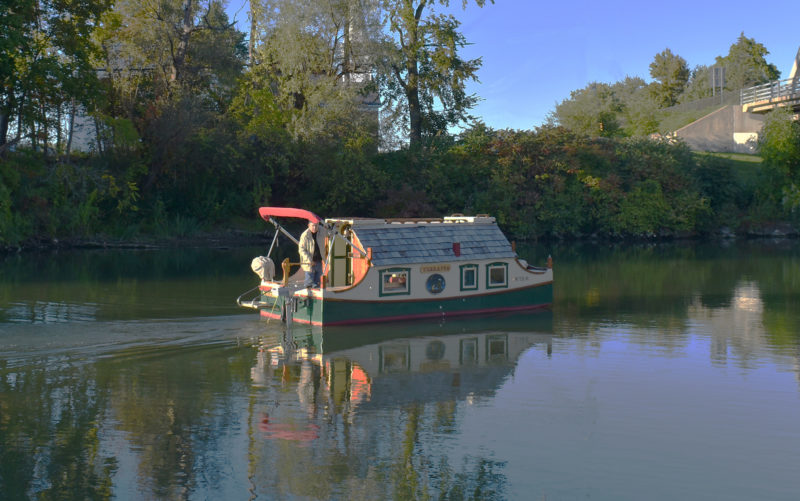 Roger Allen
Roger AllenWith a 6-hp outboard, the author’s L’Ark can cruise at 6 to 7 knots.
My wife and I have enjoyed several cruises with our L’Ark, TERRAPIN, on the Erie Canal, staying at the marinas that almost every small canal town has. While tied up, our boat attracts plenty of attention. For day trips it can comfortably carry four to six people, and if the weather turns bad, there is plenty of room in the cabin; on one trip we saw an Escargot, the L’Ark’s little sister, and I suspect its crew was envious of our standing headroom. The boat is simple to construct and easy to modify to suit individual needs. It can be very simple as designed or dressed up (as I did with our L’Ark). I’m quite happy with the design and would recommend it to anyone who wants to build a tiny houseboat.![]()
David Harris grew up in Tonawanda, New York, where the Erie Canal meets the Niagara River and halfway between lakes Erie and Ontario. At 21, he enlisted in the Coast Guard and served in Jonesport, Maine, first at a small boat station and later on an 82′ cutter. While serving Down East in the 1970s he got to know local lobstermen who were still building and using wooden boats. While in his 40s, he and his father built Bolger’s June Bug, a small sailing skiff. Several years later, David restored a run-down Catalina 30 and earned his captain’s papers to run sightseeing tours on it. He went back to college to study fine arts and design and enrolled in a class in boatbuilding at the Buffalo Maritime Center; he built a small skiff and learned how to work with fiberglass. He has owned several sailboats as well as a classic Chris-Craft cabin cruiser. After sailing for years on the turbulent waters of Lake Erie and wanting something traditional and more easily handled, he sold his last sailboat and went to work on his L’Ark canal boat, TERRAPIN.
L’Ark Particulars
[table]
Length/18′ 6″
Beam/6′ 6.75″
Height/6′ 5″
[/table]
Plans for the Escargot and the L’Ark consist of 12 pages for Escargot plus 4 pages of L’Ark modifications for the hull and cabin. The full set is available from The WoodenBoat Store for $75, print or digital format.
Is there a boat you’d like to know more about? Have you built one that you think other Small Boats Magazine readers would enjoy? Please email us!
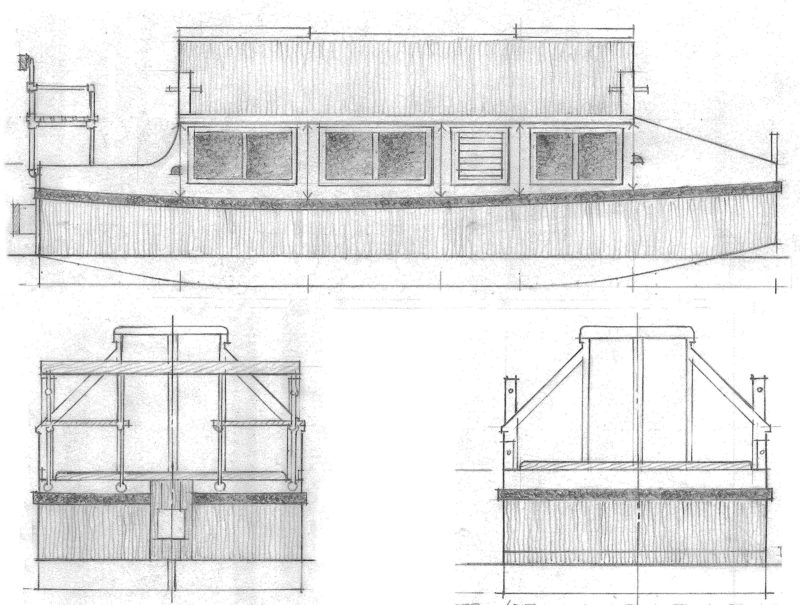

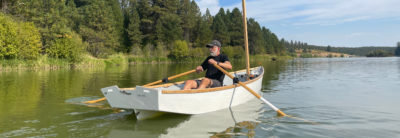
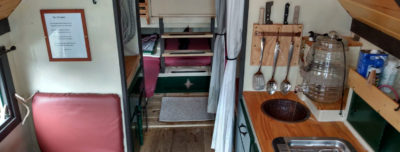


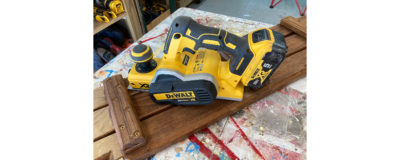
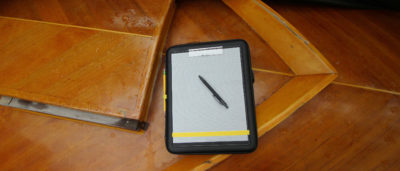
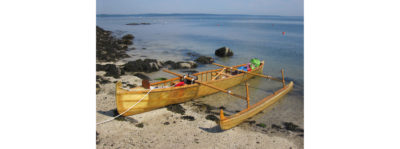
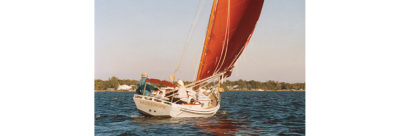
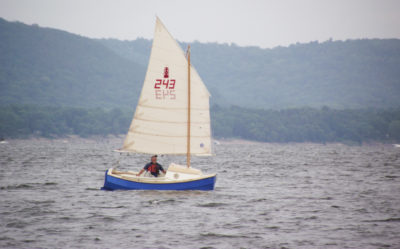
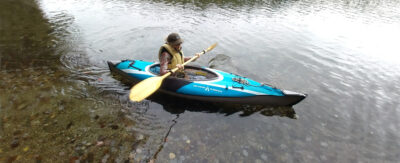
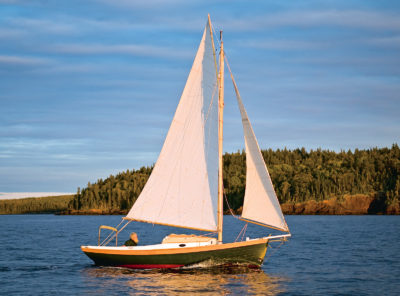
Thanks for writing about your experience building and using your L’Ark. Really appreciate your honest writing, mentioning what went wrong, what needed to be changed, the need to stand on a box for a better view. Sharing the experience gives others the confidence to try. If you make a mistake, and we all do, we can fix it and continue on.
Ken Koscik
Madison, Wisconsin
I met with Phil Thiel before building the first Escargot. I wish Phil was alive to see the work you did. I know he’d be proud and impressed. I’d seen the plans when they first came out, but your beautiful work sold it all to me. With my Escargot I could stand… or put a chair on the built in bench seat. Your roof is taller, though. I could see a fold-down seat on the back side of the cabin.
I wish you well!
Bryan
Shantyboat Living
Well done, David. Chance has put two boats on the Erie named after the testudine, your L’Ark and my 23′ 1969 Aqua Camper, TERRAPYN (Macedonian spelling). We are in Whitehall on the Champlain Canal. If we both left on the same day from our respective ends of the Erie, at 6mph maybe we’d meet somewhere about Little Falls.
Great work you’ve done, and happy cruising next season.
Tim Jennings
Cool boat! Thanks for the article.
Tom
What an inspiration. There are so many large caravans on the road, you occasionally see a houseboat/aqua-camper, however, David has created a wonderful riverboat. I would have loved to see a pic of her on the trailer.Or how she tows. I wonder if a dual-axle box trailer frame would suffice. Certainly food for thought. Well done, David. Thanks for the article.
David,
I enjoyed reading about your L’Ark project. It gave me a few ideas for my own Phil Thiel-designed project. I’ve been working on a FriendShip since 2018.
Additionally, reading articles like yours serves to inspire us builders to hang in there and keep laboring away because our launch date will eventually arrive. Happy cruising!
Charlie Edwards
@FriendShip Shantyboat Project
https://smallboatsmonthly.com/wp-content/uploads/2022/11/EdwardsFriendship0411.jpg
What a beautiful boat! My work requires me to move every 2-3 years, so I have been unable to commit to building a boat like this. However, I have long admired the Escargot and the Millie Hill and dream of the day when I am ready to build one. In the meantime, your craftsmanship gave me something to aspire to. Enjoy your cruises!
Dave, just down the road – Rochester, NY. In one of the earlier photos it looks like you are running an electric outboard. I am guessing 3hp equivalent? Was it underpowered?